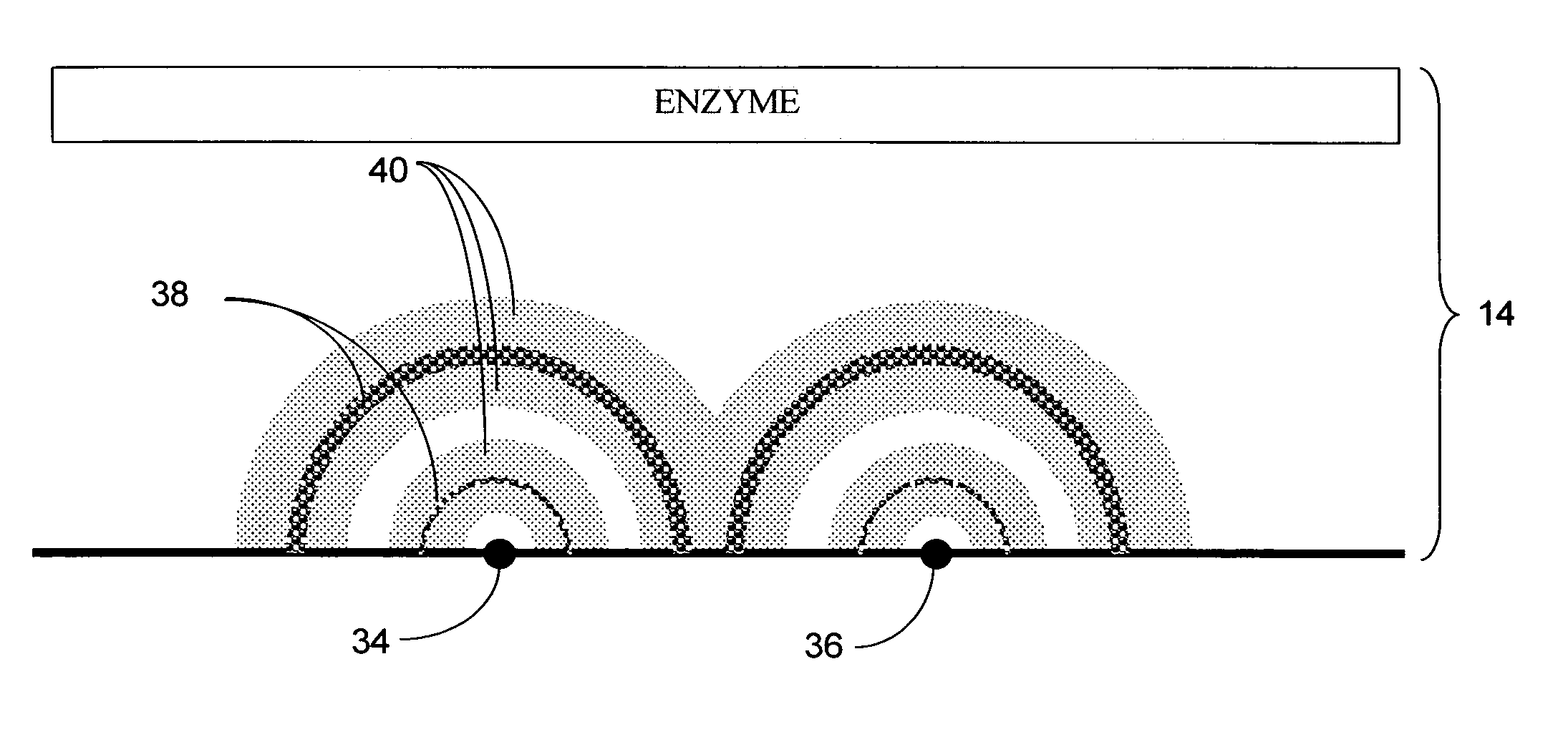Electrochemical sensors including electrode systems with increased oxygen generation
a technology of electrochemical sensors and electrode systems, applied in the field of electrochemical sensor systems and methods for increasing oxygen generation in electrochemical sensors, can solve the problems of not knowing if the blood glucose value is going up (higher) or down (lower) based on conventional methods, and diabetics are likely to find
- Summary
- Abstract
- Description
- Claims
- Application Information
AI Technical Summary
Benefits of technology
Problems solved by technology
Method used
Image
Examples
first embodiment
[0008]Accordingly, in a first embodiment, an electrochemical sensor for determining a presence or a concentration of an analyte in a fluid is provided, the sensor including a membrane system including an enzyme that reacts with the analyte; a first working electrode including a conductive material, wherein the first working electrode is configured to measure a product of the reaction of the enzyme with the analyte; and an auxiliary electrode including a conductive material, wherein the auxiliary electrode is configured to generate oxygen, wherein the auxiliary electrode is located at a proximity to the first working electrode such that oxygen generated at the auxiliary electrode diffuses to the enzyme at a location substantially above the first working electrode.
[0009]In an aspect of the first embodiment, a distance between the first working electrode and the auxiliary electrode is from about 0.5 to about 1000 microns.
[0010]In an aspect of the first embodiment, a distance between th...
second embodiment
[0018]In a second embodiment, an electrochemical sensor for determining a presence or a concentration of an analyte in a fluid is provided, the sensor including a membrane system including an enzyme that reacts with the analyte; a first working electrode including a conductive material, wherein the first working electrode is configured to measure a product of the reaction of the enzyme with the analyte; and an auxiliary electrode including a conductive material, wherein the auxiliary electrode is configured to generate oxygen; and a counter electrode including a conductive material, wherein the counter electrode is configured to reduce oxygen so as to balance current being generated by the first working electrode, wherein the auxiliary electrode is located at a proximity to the counter electrode such that oxygen generated at the auxiliary electrode diffuses to the counter electrode to be reduced thereby.
[0019]In an aspect of the second embodiment, a distance between the auxiliary el...
third embodiment
[0028]In a third embodiment, a method for generating oxygen for use at an electrochemical analyte sensor is provided, the method including providing a membrane system including an enzyme that reacts with the analyte; providing a first working electrode including a conductive material; measuring a product of a reaction of the enzyme with the analyte at the first working electrode, wherein a concentration of the product is indicative of a concentration of the analyte; providing an auxiliary electrode including a conductive material; and generating oxygen at the auxiliary electrode, wherein the auxiliary electrode is configured such that the oxygen generated at the auxiliary electrode diffuses toward the enzyme at a location substantially above the first working electrode.
[0029]In an aspect of the third embodiment, the enzyme is selected from the group consisting of glucose oxidase, amino acid oxidase, alcohol oxidase, galactose oxidase, lactate oxidase, and cholesterol oxidase.
[0030]I...
PUM
| Property | Measurement | Unit |
|---|---|---|
| distance | aaaaa | aaaaa |
| distance | aaaaa | aaaaa |
| distance | aaaaa | aaaaa |
Abstract
Description
Claims
Application Information
 Login to View More
Login to View More - R&D
- Intellectual Property
- Life Sciences
- Materials
- Tech Scout
- Unparalleled Data Quality
- Higher Quality Content
- 60% Fewer Hallucinations
Browse by: Latest US Patents, China's latest patents, Technical Efficacy Thesaurus, Application Domain, Technology Topic, Popular Technical Reports.
© 2025 PatSnap. All rights reserved.Legal|Privacy policy|Modern Slavery Act Transparency Statement|Sitemap|About US| Contact US: help@patsnap.com



